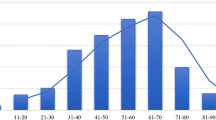Abstract
Aims of the present study were: (1) to assess the incidence of vestibular neuritis (VN) in the adult population in two cities in Croatia, (2) to identify distribution of new VN cases in the different months and seasons by years, and (3) to identify comorbidities associated with VN. This is a prospective, population-based study conducted in the cities of Zagreb and Velika Gorica, Croatia in the 2011–2012 period. All diagnoses were confirmed either with caloric test or vestibular evoked myogenic potentials within 7 days of symptom onset. Following clinical parameters were collected from all patients: age, gender, side of the lesion, month and season of symptoms onset and comorbidities. We identified 79 new cases of VN (34 in 2011, 45 in 2012). The male to female ratio was 1.1:1. The mean age at the onset of the disease was 52.3 (range 20–86) years. The average annual incidence was 11.7 per 100,000 (95 % CI 7.8–15.6) in the 2011 period and 15.5 per 100,000 (95 % CI 11.0–20.0) in the 2012 period. For both years there was no statistically significant uneven distribution in the different months or seasons by years. The most frequent comorbidities present in VN patients were hypertension (30.4 %), diabetes mellitus (8.9 %), hyperlipidemia (7.5 %) and hypothyreosis (6.3 %). Our study has shown higher incidence of VN than previously reported. We have found no evidence of seasonality of VN and significant proportion of VN patients older than 50 years who had vascular risk factors present.


Similar content being viewed by others
References
Zaper D, Adamec I, Gabelić T et al (2012) Vestibular neuronitis: pathophysiology, diagnosis and treatment. Lijec Vjesn 134:340–345
Neuhauser HK, von Brevern M, Radtke A et al (2005) Epidemiology of vestibular vertigo: a neurotologic survey of the general population. Neurology 65:898–904
Sekitani T, Imate Y, Noguchi T, Inokuma T (1993) Vestibular neuronitis: epidemiological survey by questionnaire in Japan. Acta Otolaryngol Suppl 503:9–12
Baloh RW (2003) Clinical practice. Vestibular neuritis. N Engl J Med 348:1027–1032
Bilecki MM, Bernarde GE, Mezzalira R, Maestri JE, Cardoso JM, Avila FG (2005) Seasonality in vestibular disorders. Int Tinnitus J 11:185–188
Koors PD, Thacker LR, Coelho DH (2012) Seasonality of vestibular neuronitis. Otolaryngol Head Neck Surg 147(suppl2):P221
Videla G, Bisonni A, Ciancaglini L, et al. (2013) Epidemiological and seasonal characteristics of vestibular neuritis. Neurology 80 (meeting abstracts 1):p 02.249
Kerber KA (2009) Vertigo and dizziness in the emergency department. Emerg Med Clin North Am 27:39–50
Edlow JA, Newman-Toker DE, Savitz SI (2008) Diagnosis and initial management of cerebellar infarction. Lancet Neurol 7:951–964
http://www.dzs.hr. Accessed 5 Jan 2013
Furuta Y, Takasu T, Fukuda S, Inuyama Y, Sato KC, Nagashima K (1993) Latent herpes simplex virus type 1 in human vestibular ganglia. Acta Otolaryngol Suppl 503:85–89
Hirata Y, Gyo K, Yanagihara N (1995) Herpetic vestibular neuritis: an experimental study. Acta Otolaryngol Suppl 519(Suppl):93–96
Gacek R, Gacek M (2002) The three faces of vestibular ganglionitis. Ann Otol Rhinol Laryngol 111:103–114
Theil D, Arbusow V, Derfuss T et al (2001) Prevalence of HSV-1 LAT in human trigeminal, geniculate, and vestibular ganglia and its implication for cranial nerve syndromes. Brain Pathol 11:408–413
Baloh RW, Ishyama A, Wackym PA, Honrubia V (1996) Vestibular neuritis: clinical–pathologic correlation. Otolaryngol Head Neck Surg 114:586–592
Kerber K (2012) Acute Constant Dizziness. Continuum Lifelong Learning Neurol 18:1041–1059
Chuang YM, Chern CM, Liao WH et al (2011) Comorbid intracranial vertebral artery asymmetry as a risk factor for severe vestibular neuronitis. Otol Neurotol 32:478–482
Adamec I, Skoric MK, Handzic J et al (2013) the role of cervical and ocular vestibular-evoked myogenic potentials in the follow-up of vestibular neuritis. Clin EEG Neurosci. doi:10.1177/1550059413483452
Conflict of interest
Dr. Adamec reports no disclosures. Mrs. Krbot Skorić reports no disclosures. Dr. Handžić reports no disclosures. Dr. Habek reports no disclosures.
Author information
Authors and Affiliations
Corresponding author
Rights and permissions
About this article
Cite this article
Adamec, I., Krbot Skorić, M., Handžić, J. et al. Incidence, seasonality and comorbidity in vestibular neuritis. Neurol Sci 36, 91–95 (2015). https://doi.org/10.1007/s10072-014-1912-4
Received:
Accepted:
Published:
Issue Date:
DOI: https://doi.org/10.1007/s10072-014-1912-4




